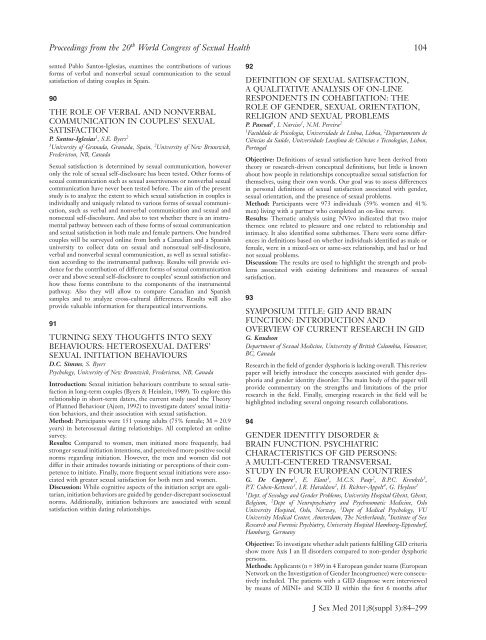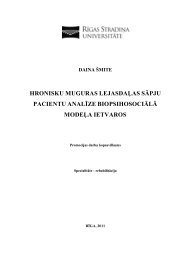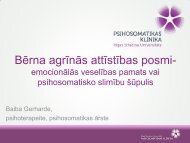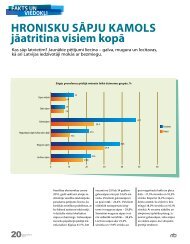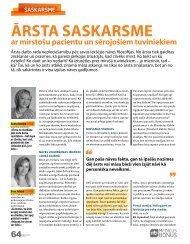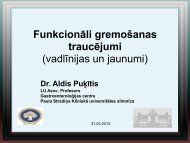103Proceedings from the 20 th World Congress of Sexual Health85A PRESENTATION BY THE MIDDLEEASTERN SEXUAL HEALTH COMMITTEE(MESHC)S. Nasserzadeh 1 , A. El-Tarahony 2 , M. Sungur 3 , E.A. Attallah 4 ,F. El-Kak 5 , Q. Beig 61 Consultant, New York, NY, USA, 2 Dubai-Springs 5, Dubai, United ArabEmirates, 3 Psychiatry Dept of Marmara University Hospital, Istanbul,Turkey, Turkey, 4 MOH, Kingdom of Bahrain, Bahrain, 5 AmericanUniversity of Beirut, Riad El-Solh, Lebanon, 6 World Population Foundation,Pakistan, PakistanThis Symposium consists of several presentations from various countriesin the Middle East to give the audience an overall knowledge ofthe sexual health education, therapy and research status in the region.The audience would be introduced to this new Committee at theWorld Association for Sexual Health and be invited to join dependingon their areas of interest.86BARRIERS TO SEEKING AND RECEIVINGHELP FOR SEXUAL CONCERNS IN MID ANDLATER LIFES. HinchliffSchool of Nursing and Midwifery, University of Sheffield, Sheffield, UKObject of study: The sexual health needs of people at mid andlater life tend to get overlooked at both a political and professionallevel. This presentation will explore the reasons why, by looking atbarriers to seeking and receiving help for sexual concerns anddifficulties.Method: Evidence from a range of sources, including a literaturereview of twenty-five articles on medical help-seeking and doctorpatientinteractions, was examined.Results: Patients reported a number of barriers to seeking help forsexual concerns including thinking that sexual changes were ‘normalwith ageing’ and assuming that their doctor would think that sex wasnot important to them ‘at their age’. Health care professional (HCP)barriers to providing sexual health care related to limited knowledgeof mid and later life sexuality issues, as well as inadequate training atmedical school. Doctors tended not to take a proactive approach tosexual health with ‘older’ patients, but patients were more likely toseek help if their doctor had asked about sexual function during aprevious consultation.Conclusion: The implications for sexual well-being if the doctor doesnot ask and the patient does not tell are clear. Providing educationabout sexuality for doctors and other HCPs is crucial if we are to meetthe needs of ‘older’ patients in useful and effective ways.87FINDINGS FROM ORIGINAL RESEARCH,CONDUCTED IN SHEFFIELD, ON THEASSOCIATION BETWEEN TESTOSTERONELEVELS AND PSYCHIATRIC FACTORSA.K. Wood 1 , R. Runciman 2 , Y. Abassi 3 , K. Wylie 11 Poterbrook Clinic, Sheffield Health and Social Care NHS Foundation Trust,2 Sheffield University, 3 Sheffield Health and Social Care NHS FoundationTrust, Sheffield, UKObjective: To Explore the Association between Low TestosteroneLevels and Psychiatric Illness in Patients presenting, in Sheffield, withErectile Dysfunction.Method: During a Service Evaluation Study, data was reviewed fromthe MED database, in Sheffield.1638 patient records, for whom testosterone values were recorded,were reviewed.They were divided into three age categories, 18–49,50–64 and 65+.For each of these age groups we looked at their testosterone levelsand categorised those into Low, Borderline and Normal.We then looked for each age group, at the comparative levels ofpsychiatric illness and whether these varied with testosterone levels ofLow, Borderline or Normal.Results: In our youngest age-group of 18–49 year-olds, 26.9% ofthose with low testosterone had a psychiatric disorder compared withonly 14.6% who had a normal testosterone. In the middle age groupof 50–64 year-olds, 17.5% of those with low testosterone had a psychiatricdisorder compared with 14.7% who had a normal testosterone.In the older age patients 13.2% of those with low testosterone had apsychiatric disorder compared with only 7.4% who had a normaltestosterone.Conclusion: Within our service, data appeared to indicate some associationbetween Low Testosterone and Psychiatric Disorder, particularlyin younger men.Take home message: There may be an association between lowtestosterone and psychiatric disorder, in patients with erectiledysfunction.88CURRENT GUIDELINES ON TESTOSTERONEREPLACEMENT IN MEN AND WOMENK. WyliePorterbrook Clinic, Sheffield, UKThe British Society for Sexual Medicine, along with several otherorganisations, have issued new guidelines for the management of testosteronedeficiency and the treatment of sexual disorders in men andwomen. These are the first guidelines developed by UK organisationson the subject of the diagnosis and treatment of sexual disorders inwomen. There remains a lack of awareness and a reluctance from cliniciansand patients to discuss sexual symptoms. These guidelines resultfrom a thorough review of the published research on the symptoms,diagnosis and treatments of testosterone deficiency and sexual disordersin men and women and present a number of recommendationssummarised below.Women should be routinely asked if they have any sexual concernsat consultations at contraceptive and sexual health clinics and at cervicalscreening, postnatal and menopausal assessments. This especiallyapplies to women at higher risk, such as those who have prematuresurgical menopause, vaginal dryness, depression or a history of sexualabuse. Likewise, there are many opportunities to ask men about anysexual problems. Assessment may be undertaken over several consultationsand should cover sexual and medical history and may involve useof validated questionnaires to assess female sexual function. Careshould be taken to rule out pre-existing medical conditions such asdiabetes, which may affect sexual function. Treatment should be basedupon clinical symptoms and individually tailored. All patients diagnosedshould be offered the opportunity to attend psychosexual and/or couples counselling or sex therapy. Additionally, patients may beoffered a number of pharmaceutical options.89J Sex Med 2011;8(suppl 3):84–299STRIVING FOR IDEALS: THE INTERSECTIONOF SEXUAL AND ROMANTIC DOMAINSE.S. ByersPsychology, University of New Brunswick, Fredericton, NB, CanadaSymposium overview: This international symposium includes fourpapers examining the sexual and romantic relationships of adolescentsand adults. The first paper, presented by Lucia O’Sullivan, Ph.D.,examines the contributions of dating and sexual experience to Canadianadolescents’ perceptions of the quality of their current relationship.The second paper, presented by Deanne Simms, examinescognitive and behavioural components of the sexual script for sexualinitiations among dating couples in Canada. The third paper, by PatriciaPascoal, investigates the personal definitions of sexual satisfactionof Portuguese individuals living with a partner. The final paper, prejsm_2325.indd1035/20/2011 8:18:13 PM
Proceedings from the 20 th World Congress of Sexual Health 104sented Pablo Santos-Iglesias, examines the contributions of variousforms of verbal and nonverbal sexual communication to the sexualsatisfaction of dating couples in Spain.90THE ROLE OF VERBAL AND NONVERBALCOMMUNICATION IN COUPLES’ SEXUALSATISFACTIONP. Santos-Iglesias 1 , S.E. Byers 21 University of Granada, Granada, Spain, 2 University of New Brunswick,Fredericton, NB, CanadaSexual satisfaction is determined by sexual communication, howeveronly the role of sexual self-disclosure has been tested. Other forms ofsexual communication such as sexual assertiveness or nonverbal sexualcommunication have never been tested before. The aim of the presentstudy is to analyze the extent to which sexual satisfaction in couples isindividually and uniquely related to various forms of sexual communication,such as verbal and nonverbal communication and sexual andnonsexual self-discolsure. And also to test whether there is an instrumentalpathway between each of these forms of sexual communicationand sexual satisfaction in both male and female partners. One hundredcouples will be surveyed online from both a Canadian and a Spanishuniversity to collect data on sexual and nonsexual self-disclosure,verbal and nonverbal sexual communication, as well as sexual satisfactionaccording to the instrumental pathway. Results will provide evidencefor the contribution of different forms of sexual communicationover and above sexual self-disclosure to couples’ sexual satisfaction andhow these forms contribute to the components of the instrumentalpathway. Also they will allow to compare Canadian and Spanishsamples and to analyze cross-cultural differences. Results will alsoprovide valuable information for therapeutical interventions.91TURNING SEXY THOUGHTS INTO SEXYBEHAVIOURS: HETEROSEXUAL DATERS’SEXUAL INITIATION BEHAVIOURSD.C. Simms, S. ByersPsychology, University of New Brunswick, Fredericton, NB, CanadaIntroduction: Sexual initiation behaviours contribute to sexual satisfactionin long-term couples (Byers & Heinlein, 1989). To explore thisrelationship in short-term daters, the current study used the Theoryof Planned Behaviour (Ajzen, 1992) to investigate daters’ sexual initiationbehaviors, and their association with sexual satisfaction.Method: Participants were 151 young adults (75% female; M = 20.9years) in heterosexual dating relationships. All completed an onlinesurvey.Results: Compared to women, men initiated more frequently, hadstronger sexual initiation intentions, and perceived more positive socialnorms regarding initiation. However, the men and women did notdiffer in their attitudes towards initiating or perceptions of their competenceto initiate. Finally, more frequent sexual initiations were associatedwith greater sexual satisfaction for both men and women.Discussion: While cognitive aspects of the initiation script are egalitarian,initiation behaviors are guided by gender-discrepant sociosexualnorms. Additionally, initiation behaviors are associated with sexualsatisfaction within dating relationships.92DEFINITION OF SEXUAL SATISFACTION,A QUALITATIVE ANALYSIS OF ON-LINERESPONDENTS IN COHABITATION: THEROLE OF GENDER, SEXUAL ORIENTATION,RELIGION AND SEXUAL PROBLEMSP. Pascoal 1 , I. Narciso 1 , N.M. Pereira 21 Faculdade de Psicologia, Universidade de Lisboa, Lisboa, 2 Departamento deCiências da Saúde, Universidade Lusofona de Ciências e Tecnologias, Lisbon,PortugalObjective: Definitions of sexual satisfaction have been derived fromtheory or research-driven conceptual definitions, but little is knownabout how people in relationships conceptualize sexual satisfaction forthemselves, using their own words. Our goal was to assess differencesin personal definitions of sexual satisfaction associated with gender,sexual orientation, and the presence of sexual problems.Method: Participants were 973 individuals (59% women and 41%men) living with a partner who completed an on-line survey.Results: Thematic analysis using NVivo indicated that two majorthemes: one related to pleasure and one related to relationship andintimacy. It also identified some subthemes. There were some differencesin definitions based on whether individuals identified as male orfemale, were in a mixed-sex or same-sex relationship, and had or hadnot sexual problems.Discussion: The results are used to highlight the strength and problemsassociated with existing definitions and measures of sexualsatisfaction.93SYMPOSIUM TITLE: GID AND BRAINFUNCTION: INTRODUCTION ANDOVERVIEW OF CURRENT RESEARCH IN GIDG. KnudsonDepartment of Sexual Medicine, University of British Columbia, Vanouver,BC, CanadaResearch in the field of gender dysphoria is lacking overall. This reviewpaper will briefly introduce the concepts associated with gender dysphoriaand gender identity disorder. The main body of the paper willprovide commentary on the strengths and limitations of the priorresearch in the field. Finally, emerging research in the field will behighlighted including several ongoing research collaborations.94GENDER IDENTITY DISORDER &BRAIN FUNCTION. PSYCHIATRICCHARACTERISTICS OF GID PERSONS:A MULTI-CENTERED TRANSVERSALSTUDY IN FOUR EUROPEAN COUNTRIESG. De Cuypere 1 , E. Elaut 1 , M.C.S. Paap 2 , B.P.C. Kreukels 3 ,P.T. Cohen-Kettenis 3 , I.R. Haraldsen 2 , H. Richter-Appelt 4 , G. Heylens 11 Dept. of Sexology and Gender Problems, University Hospital Ghent, Ghent,Belgium, 2 Dept of Neuropsychiatry and Psychosomatic Medicine, OsloUniversity Hospital, Oslo, Norway, 3 Dept of Medical Psychology, VUUniversity Medical Center, Amsterdam, The Netherlands, 4 Institute of SexResearch and Forensic Psychiatry, University Hospital Hamburg-Eppendorf,Hamburg, GermanyObjective: To investigate whether adult patients fulfilling GID criteriashow more Axis I an II disorders compared to non-gender dysphoricpersons.Methods: Applicants (n = 389) in 4 European gender teams (EuropeanNetwork on the Investigation of Gender Incongruence) were consecutivelyincluded. The patients with a GID diagnose were interviewedby means of MINI+ and SCID II within the first 6 months afterJ Sex Med 2011;8(suppl 3):84–299jsm_2325.indd 1045/20/2011 8:18:13 PM


